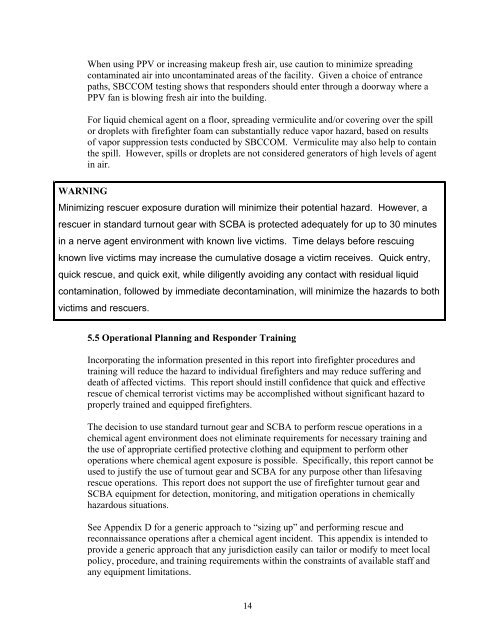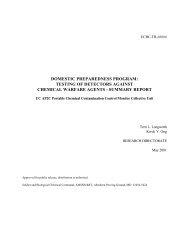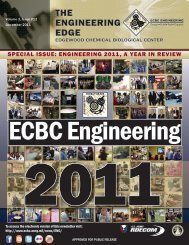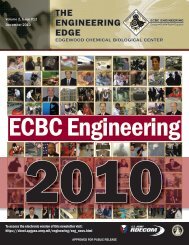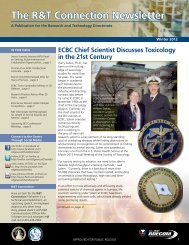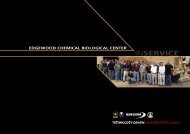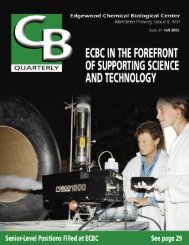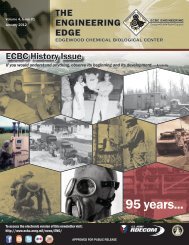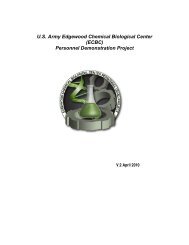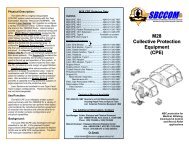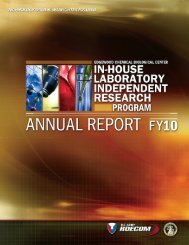(FFPE) with Self-Contained Breathing Apparatus (SCBA) for Rescue
(FFPE) with Self-Contained Breathing Apparatus (SCBA) for Rescue
(FFPE) with Self-Contained Breathing Apparatus (SCBA) for Rescue
Create successful ePaper yourself
Turn your PDF publications into a flip-book with our unique Google optimized e-Paper software.
WARNING<br />
When using PPV or increasing makeup fresh air, use caution to minimize spreading<br />
contaminated air into uncontaminated areas of the facility. Given a choice of entrance<br />
paths, SBCCOM testing shows that responders should enter through a doorway where a<br />
PPV fan is blowing fresh air into the building.<br />
For liquid chemical agent on a floor, spreading vermiculite and/or covering over the spill<br />
or droplets <strong>with</strong> firefighter foam can substantially reduce vapor hazard, based on results<br />
of vapor suppression tests conducted by SBCCOM. Vermiculite may also help to contain<br />
the spill. However, spills or droplets are not considered generators of high levels of agent<br />
in air.<br />
Minimizing rescuer exposure duration will minimize their potential hazard. However, a<br />
rescuer in standard turnout gear <strong>with</strong> <strong>SCBA</strong> is protected adequately <strong>for</strong> up to 30 minutes<br />
in a nerve agent environment <strong>with</strong> known live victims. Time delays be<strong>for</strong>e rescuing<br />
known live victims may increase the cumulative dosage a victim receives. Quick entry,<br />
quick rescue, and quick exit, while diligently avoiding any contact <strong>with</strong> residual liquid<br />
contamination, followed by immediate decontamination, will minimize the hazards to both<br />
victims and rescuers.<br />
5.5 Operational Planning and Responder Training<br />
Incorporating the in<strong>for</strong>mation presented in this report into firefighter procedures and<br />
training will reduce the hazard to individual firefighters and may reduce suffering and<br />
death of affected victims. This report should instill confidence that quick and effective<br />
rescue of chemical terrorist victims may be accomplished <strong>with</strong>out significant hazard to<br />
properly trained and equipped firefighters.<br />
The decision to use standard turnout gear and <strong>SCBA</strong> to per<strong>for</strong>m rescue operations in a<br />
chemical agent environment does not eliminate requirements <strong>for</strong> necessary training and<br />
the use of appropriate certified protective clothing and equipment to per<strong>for</strong>m other<br />
operations where chemical agent exposure is possible. Specifically, this report cannot be<br />
used to justify the use of turnout gear and <strong>SCBA</strong> <strong>for</strong> any purpose other than lifesaving<br />
rescue operations. This report does not support the use of firefighter turnout gear and<br />
<strong>SCBA</strong> equipment <strong>for</strong> detection, monitoring, and mitigation operations in chemically<br />
hazardous situations.<br />
See Appendix D <strong>for</strong> a generic approach to “sizing up” and per<strong>for</strong>ming rescue and<br />
reconnaissance operations after a chemical agent incident. This appendix is intended to<br />
provide a generic approach that any jurisdiction easily can tailor or modify to meet local<br />
policy, procedure, and training requirements <strong>with</strong>in the constraints of available staff and<br />
any equipment limitations.<br />
14


